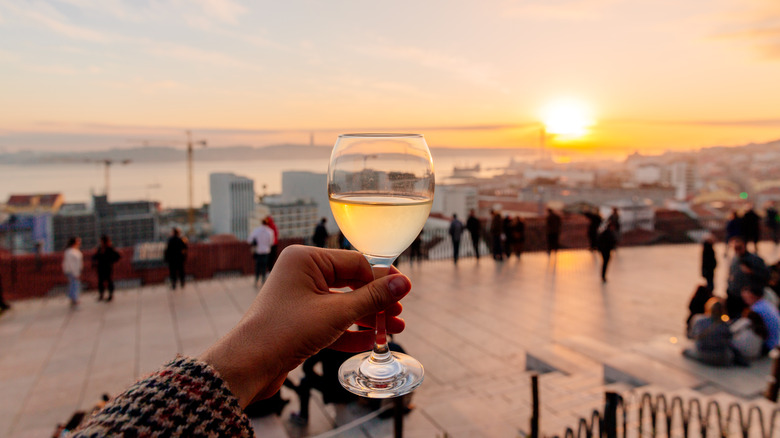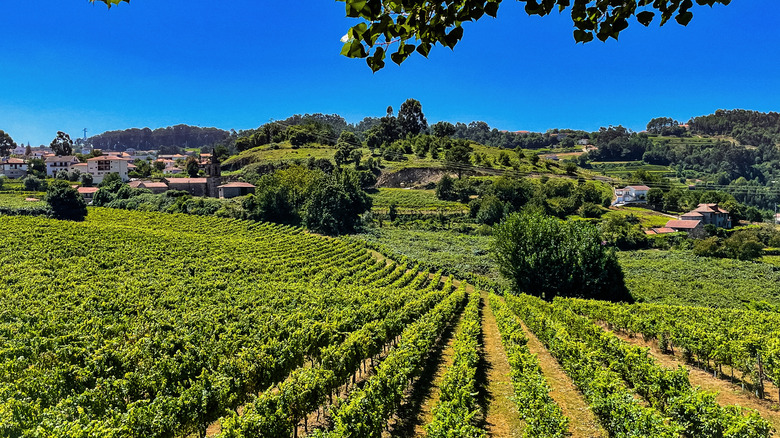The Most Misunderstood Wine In All Of Europe Is A Refreshing Favorite Of Rick Steves
When it comes to European wines, connoisseurs often wax poetic about French Bordeaux, Italian Chianti, or Spanish Rioja. However — tucked away in the northwestern corner of the Iberian Peninsula — there's a sweet and zesty contender that's captured the heart of renowned travel expert Rick Steves: Portugal's vinho verde. Often translated as "green wine," vinho verde is, according to the author's website, the "most misunderstood wine" in Europe.
For starters, there's the name. Believe it or not, vinho verde isn't actually green in color, as some might assume. Instead, the "green" in its name refers to its young age — specifically, in regards to the fact that these types of wine are generally released and drunk within just one year of bottling. This quick turnaround from vine to glass often results in a wine that's crisp, light, and slightly effervescent — which makes it perfect for sipping away on a warm summer day in one of Portugal's most beautiful coastal towns or paired with one of the many seafood dishes the country is well-known for. While most vinho verde wines are white, there are also red and rosé varieties, as well.
The unique characteristics of vinho verde
First things first, an introduction. Vinho verde generally hails from the Minho region in northern Portugal. An area known for its lush, green landscapes and cool, rainy climate, this terroir — a fancy term that describes all of the different elements that go into growing wine grapes, such as the climate, soil, and elevation — contributes to the wine's distinctive profile.
In terms of flavor profile, the grape varieties used in vinho verde — such as alvarinho, loureiro, and trajadura — tend to thrive in this environment. This ultimately leads to grapes with a high acidity and low sugar content, both of which are key factors that determine the wine's crisp, refreshing nature. The high acidity also gives the wine a mouth-watering quality that means it'll pair well with a wide range of foods — from grilled sardines to fresh oysters, light salads, and even a plateful of fried calamari.
Along with its citrusy and stone fruity notes, one of the most notable characteristics of vinho verde is its slight fizz — a result of malolactic fermentation, which naturally produces the carbon dioxide that then creates these bubbles. The result is a wine with a subtle sparkle — not akin to champagne, though — that's got both a refreshing quality and a low alcohol content that typically ranges between 10-12% ABV. Oh, and better yet, it's also a great option if you're hoping to save by ordering cheaper alcohol in Europe, with some local bottles (yes, bottles) sitting comfortably around the $5 mark.
The best spots for sampling some vinho verde
Aside from snagging a favored spot on Rick Steves' list of "Best and Worst of Europe," vinho verde is also a staple of Portuguese wine culture. And while vinho verde is specifically produced in the north, you can find excellent bottles pretty much everywhere you decide to visit. However, like with most things in life, it's always best to go straight to the source.
That said, if you're in Porto — a Steves-approved destination that's also home to what he considers one of the best food halls in Europe — make sure you head over to Quinta da Aveleda. Located roughly 30 minutes outside of the city, the estate is tucked away in the heart of the vinho verde region and offers various tours and experiences that visitors can enjoy — from tastings to workshops, events, and more.
Alternatively, and if you're not short on time, another must-visit destination on your vinho verde excursion is Soalheiro. Located along the northern border with Spain — and roughly two hours outside of Porto — the winery is one of the most well-known names in the industry. From vineyard tours to wine tasting, herbal teas, gastronomic experiences, and even a guest house that you can stay in overnight, Soalheiro boasts stunning landscapes combined with top-notch attention to detail. Other stops in your itinerary should try to include Quinta do Ameal and Quinta das Arcas, as well as other local wineries such as Quintas De Melgaço, Quinta De Lourosa, Quinta Paço De Calheiros (Calheiros Manor), and Quinta de Santa Cristina.


